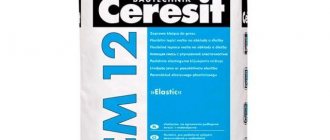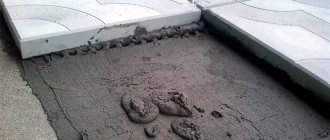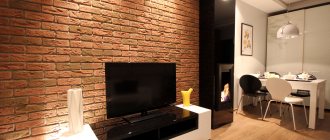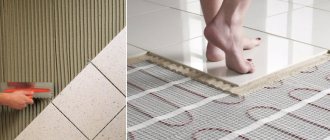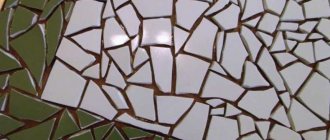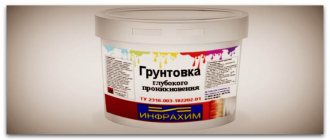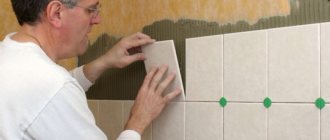Various materials used in the construction of building walls require the use of different finishing methods. Concrete has increased hardness and the ability to absorb moisture, which can make finishing concrete surfaces difficult. Before gluing ceramic tiles to a concrete wall, it is necessary to evaluate the evenness and ability of the wall surface to adhere to the glue. Possible difficulties when gluing tiles to concrete walls were laid down even during the pouring of concrete mortar during construction.
The fact is that modern technologies for the construction of reinforced concrete buildings involve the use of reusable formwork panels. A sheet of special plywood is attached to the steel frame of the shield, the surface of which forms the surface of the wall. To prevent the plywood from sticking to the mortar, its front side is treated with a special lubricant, which penetrates the surface layer of concrete and subsequently impairs its adhesion.
The unevenness of the walls and corners is a consequence of poorly assembled formwork, which, when pouring the mortar, could bend or completely separate at the joints. Unevenness can also be caused by careless sealing of cracks in the joints of walls and ceilings. Often outlets and switches are on top of dome-shaped projections for the same reason.
How to glue tiles to concrete
Tile adhesive can be purchased at any hardware store. Most materials that are used to construct buildings require a specific finishing method, which differ from each other. As for concrete, this is a material that has increased strength and is able to absorb moisture well. This nuance makes it difficult to decorate walls with ceramic tiles. Before starting work, it is necessary to evaluate the condition and tenacity of the walls with the adhesive composition and, of course, their evenness, because during work, it is unlikely that anyone will be happy about the difficulties.
Wall marking
Before you begin laying ceramic tiles, make preliminary calculations. Tiles are not wallpaper, and the slightest mistake at the beginning will complicate the work when joining them in corners, in places where faucets, sinks and other equipment are installed.
If the sink is easy to remove, remove it. An even and beautiful joining line between the tile row and the bathtub can be ensured by gluing a plastic or aluminum profile. Also, a profile or corner will help out when joining tiles on external or internal corners, if it is difficult to trim the tiles evenly to size.
The unevenness of the floor can be compensated for by securing a metal or wooden straight strip or profile to install the first (lower) row, setting it horizontally in level.
Compare the dimensions of the tiles and walls in advance. In order to ensure that the tiles are cut symmetrically on different sides of the wall (if you wish), model the future appearance of the wall to scale on paper, taking into account the gaps between the tiles.
How and with what to glue ceramic tiles to concrete
Experienced specialists know what to use when working with ceramic tiles when attached to concrete. Most often, if the slab comes off, they use paste-type glue or a dry mixture in their work. Which method you use is a matter of your choice.
Paste-like glue or mastic has a thick consistency and contains water. Due to the fact that after application the moisture evaporates, the adhesive composition hardens. This material is easy to use.
If we talk about dry mixtures, they contain sand and cement.
These mixtures have a number of advantages over the previous representative:
- Available in price;
- Can be used in various types of work;
- They are the most reliable;
- They are also in demand for external cladding work.
Adhesive compositions for boards have their own recipe, which determines their purpose for gluing to a specific surface.
Below is the main classification of installation adhesives:
- Universal glue. It is the most popular, as it is a multi-purpose binder.
- Basic glue. Used for gluing small slabs onto flat surfaces.
- Reinforced glue. Used for large slabs, as well as for gluing loose floor ceramics.
- White glue. Designed for laying mosaics or transparent elements.
- Highly specialized adhesives. Used for surfaces exposed to high temperatures or high humidity.
Based on this list, you can choose exactly the glue that is suitable for your type of work.
How and with what to glue ceramic tiles to concrete
Experienced specialists know what to use when working with ceramic tiles when attached to concrete. Most often, if the slab comes off, they use paste-type glue or a dry mixture in their work. Which method you use is a matter of your choice.
Paste-like glue or mastic has a thick consistency and contains water. Due to the fact that after application the moisture evaporates, the adhesive composition hardens. This material is easy to use.
When gluing tiles, you do not need to apply too thick a layer of glue
If we talk about dry mixtures, they contain sand and cement.
These mixtures have a number of advantages over the previous representative:
- Available in price;
- Can be used in various types of work;
- They are the most reliable;
- They are also in demand for external cladding work.
Adhesive compositions for boards have their own recipe, which determines their purpose for gluing to a specific surface.
Below is the main classification of installation adhesives:
- Universal glue. It is the most popular, as it is a multi-purpose binder.
- Basic glue. Used for gluing small slabs onto flat surfaces.
- Reinforced glue. Used for large slabs, as well as for gluing loose floor ceramics.
- White glue. Designed for laying mosaics or transparent elements.
- Highly specialized adhesives. Used for surfaces exposed to high temperatures or high humidity.
Based on this list, you can choose exactly the glue that is suitable for your type of work.
How to glue tiles
The technology for laying tiles is simple. Main stages:
- Puttying. Used to increase the adhesion of glue to walls. To proceed to the next step, you must wait until it dries completely. Information about this can be found on the packaging.
- Layout. The stage at which parts are tried on and adjusted, and markings are made on the wall
- Searching for the horizon. Responsible moment. Using a building level, you need to draw a “starting” horizontal line on the wall. The lower it is located to the floor covering, the better.
- Applying glue. The composition is applied with a notched trowel. The width of the application is slightly greater than the height of one tile.
- Laying tiles. The tiles are applied piece by piece to the surface, slightly pressing. Compliance with geometry is checked using a building level. Crosses. They are used to achieve equal gaps between tiles over the entire surface.
Making your own tile adhesive
Self-prepared raw materials for work are the key to quality repairs.
The first option of raw materials for which you will need:
- foam plastic blocks 20x20x20 mm;
- acetone.
Blocks are laid out on the back side of the tile, on all corners and in the middle, and acetone is carefully dripped on top. After a few seconds, the foam blocks begin to dissolve. The resulting solution firmly adheres the tiles to the wall.
For the second option for preparing the solution, you will need sand, cement, PVA glue, and water. The basis here is sand, it is taken in a fine fraction, purified.
Cement and sand are taken in a ratio of 1 to 3.
The tile solution is prepared before use and must be used within three hours. PVA glue is added after mixing bulk materials. Half a kilo of PVA is spent on a bucket of solution.
The solution is ready for use if it has reached a uniform consistency.
The negative side of this preparation is that all components must be purchased separately. This option is advisable if the components are available.
To improve the quality of your home solution, you can add components that improve its properties: liquid soap, oil paint, liquid glass.
How to glue a fallen tile back to the old place
If a tile on the floor or wall has come off or started to wobble, especially if it has fallen off, you need not only to stick it on or replace one tile with another, but also to understand why this happened. Perhaps the previous sticker became loose due to the fact that it was placed poorly or the priming solution was used incorrectly. In any case, wall tiles or floor ceramics can quickly return to their place. In order to fix the problem, it is not necessary to go to the hardware store for new material to glue together the peeling slab with the wall. Look through the inventory left over from previous renovations. Of course, this option is unlikely to work if the problem affects most of the surface.
Before gluing the fallen tiles, it is worth clearing the surface of debris and old adhesive residues.
However, if there is one or more tiles, for gluing you can use:
- Remains of old tile adhesive. Here we are talking exclusively about the dry mixture. Provided that its storage was correct, it will not lose its properties even after a year. If we talk about liquid consistency, then it can be used according to the expiration date. Most often it is no more than two weeks.
- Dry cement. Using cement, you can make the amount of mortar that will be necessary for work. To do this, it is mixed with sand in a ratio of 1 to 3. If you doubt the strength of this composition, add PVA glue.
- Silicone type sealant. This material is used exclusively in cases where a small fragment has fallen off. It is not recommended to use it for large parts, as they will most likely fall off again.
- Liquid Nails. They have proven themselves well in relation to fixing tiles. In order for the part to be firmly attached, nails must be applied using a point method over the entire surface of the material. Once the nails are applied, you should wait about 40 seconds before attaching. This method is not recommended for attaching tiles to the floor, since the reliability of this method comes last.
- Assembly adhesive. Can be used if repairs are urgently needed. Its application is elementary, and strength and durability are ensured. After fastening this way, the tile is unlikely to fall off. The only thing you might not like about this method is the price. Such repairs will be very expensive.
Briefly about the main thing
The reasons for tiles peeling off from the base can be not only long-term use, but also the wrong choice of materials and violation of masonry technology.
For gluing facing materials, there are specialized compositions that are made in the form of a paste or powder.
In addition to tile adhesive, liquid nails, sealants, thick oil paint or bitumen mastic can be used for short-term repairs of individual areas.
Before gluing the tiles, it is important to properly prepare the removed cladding and base.
The preparatory stage includes removing the old masonry composition, leveling the base, and priming.
After the glue has dried, you can begin to completely fill the joints with specialized grout to a depth equal to the thickness of the tile.
Ratings 0
How to glue fallen tiles?
The choice of a suitable composition depends on the characteristics of the surfaces, weight and size of the products.
Any product must have certain properties:
- Adhesion.
- Compliance with the base material (wood, brick, stone, plastic, concrete, porous types).
- Glue is available for interior and exterior use.
- The mixture is determined by the place where the tiles are laid - horizontal and vertical surfaces.
- Curing time at different temperatures and humidity levels.
- Waterproof for the bathroom.
There are several types of products that will help glue ceramic elements.
Adhesive compositions
For large-sized and floor fragments, an enhanced solution is more suitable.
For wall cladding you can use inexpensive mixtures:
- The most effective solution is Ceresit, intended for installing tiles in the bathroom. It is water resistant, making it suitable for rooms with high humidity. The product protects fragments from sliding, but it cannot be used for underfloor heating systems.
- Knauf is bought for finishing work in bathrooms. It has high adhesion, is able to withstand temperature changes, and protects surfaces from fungus and mold. Suitable for major repairs, minor ongoing restoration can also be done. The composition is used for walls, ceilings and floors from different materials.
- Eunice is a mixture that can withstand a maximum weight of up to 70 kg. In addition to excellent waterproof qualities, it is frost-resistant, which allows it to be used in the bathroom, on the terrace, balcony, loggia. The solution adheres well to almost all types of base.
It is recommended to purchase a leveler, which will facilitate the installation process. If the glue remains after the main finishing, this is the best option, provided that it is suitable and of high quality.
Mastic
An option suitable for all types of finishing, but there are a number of restrictions in use. They are made on a rubber or caoutchouc base, which means they are resistant to moisture.
The product keeps the tiles from sliding, is convenient to use, and has a low cost. But mastic is not able to withstand temperature fluctuations.
When laying on such a composition, it is recommended to monitor the condition of the walls; they must be perfectly smooth. This is due to the need for a very thin layer of application.
An increase in quantity will affect the appearance of the coating. Also, do not allow small debris and dust to get into the solution.
A mixture of cement and sand
The most common method of tile restoration. Among the well-known components are polymer additives that improve adhesion.
Latex impurities increase elasticity and prevent deformation of the frozen film, its drying out and cracking.
If you decide to make the solution yourself, choose a suitable brand of cement, sifted sand without clay inclusions, in order to prevent a decrease in density.
Adding polyvinyl acetate adhesive will provide moisture resistance. Detergents are designed to provide elasticity and improve performance.
Other solutions
In addition to compositions directly intended for gluing tiles, there are solutions that can be used for emergency gluing of tiles.
To restore elements, you can use several types of different compositions:
- The sealant is suitable for gluing broken fragments or small tiles, but it is not durable.
- Epoxy and bitumen resins are suitable to firmly adhere the tiles. It is quite expensive, so it is chosen for the restoration of one or two products. The best option is a mixture of Portland cement, sand and glue.
- Modern paints are not afraid of moisture; they are used in emergency cases when there are no other means at hand.
- Liquid nails should be acrylic based. This is a safe solution designed for quick repairs. This composition is afraid of any liquids; under their influence, it loses its properties.
- Craftsmen have come up with another way to quickly glue ceramics. Place small pieces of foam plastic on the corners of the square, apply two or three drops of acetone and press firmly against the wall. Under the influence of the solvent, the material turns into a viscous, plastic mass that instantly hardens.
Tips for choosing
It is better to lay ceramic tiles using water-soluble compounds Titan WB 50 or Solvent Free as liquid nails.
Nail Power or Teb Surround - for finishing rooms such as a bathroom with high moisture resistance.
For massive tiles, it is preferable to use Zigger 99, LN 901, Heavy Duty.
Tightbond Multi Purpos is solvent based. Has excellent adhesion to building surfaces (brick, dry plaster, concrete). It is also successfully used when gluing the surfaces of parts made of ceramics, plastic, wood, foam plastic, metal, fiberboard, and chipboard.
For work on laying ceramic tiles using liquid nails, you need to pay attention to the main aspects when preparing and carrying out the work process:
- Strength in connecting tiles to the surface
- What surfaces are liquid nails designed for – vertical/horizontal/various.
- Internal, external, variable works
- Time for hardening and final hardening
- Since such adhesives are not cheap, before purchasing the required amount of glue, you need to consult with specialists and sellers - consultants on choosing the type and type of glue, and read the instructions for use.
Masonry materials
On the market of building materials for facing work, manufacturers offer a wide range of ready-made compositions and mixtures with various properties. Let's look at what tiles can be glued to during major or local repairs. Based on consistency, they are divided into dry, liquid and paste-like products. The latter can only be used for tiles with a smooth back surface and a flat base. It is important to choose the rest taking into account the maximum permissible layer. Exceeding the nominal limit will result in low solids quality and poor fixation of any tile.
Let's look at how you can glue loose ceramic tiles to the wall:
- Tile adhesive . Specialized glue is available for sale in varying quantities. If there are residues after large-scale work, it is important to pay attention to the condition of the product and expiration dates. A faulty composition can rarely be used even for a short-term solution to problems.
Sample of dry tile adhesive Source keramicheskaya-plitka.ru
Procedure
Before gluing the fallen tiles to the floor or wall, the facing material and the base must be properly prepared. The process begins with the removal of old masonry mortar. A grinder, a hammer with a chisel, a scraper, and a cord brush may come in handy here.
Often an additional layer of tile adhesive is used to compensate for unevenness on the surface. That is, after removing the remaining unsuitable solution, you need to level the working area. There should be no protrusions or depressions here.
After the site has dried, according to the technology, priming is performed before gluing the fallen tiles. The composition is selected in accordance with the operating conditions and condition of the wall. That is, you can use strengthening, dust-removing, impregnating or moisture-resistant soil with antiseptic additives. Some samples according to the instructions are applied in 2-3 layers.
Primer to increase adhesion Source enzo.ru
Next you can glue the tiles. Adjustment of the position of products is carried out using crosses or improvised means. After the masonry composition has completely dried, the joints are grouted with the material intended for this purpose. There are no alternative options here. The main thing is that the seam should be as deep as the thickness of the tile and filled without gaps.
What to do in this case
What to do if the tiles on the floor or wall still fall off? There is no need to despair, because there is far more than one way out of the situation. The first thing that comes to mind is to glue the old tile back. To do this, you need to clear the space for its installation and clearly install it in its proper place, level with the rest.
Be sure to first clean the grout from both the old tiles and the wall or floor.
This method is acceptable only if the tile remains intact, otherwise it is best to replace it with a new element. Surely after the repair you still have several tiles from the same batch. If not, then try to find the same one on sale. If this is not possible, then you can choose tiles of a different color. You can link this contrast with any interior item. Use a decorative insert with a similar shade of detail or a completely different tile structure, even a colored mosaic. It will look very original and interesting.
If this option is not for you, and the old tiles are not very damaged, try gluing them together. This must be done in such a way that the fragments are joined end to end with minimal seam.
To prevent further destruction of the masonry, try to determine the possible cause of the tiles peeling off. In principle, this is not difficult to do. Voids are immediately noticeable, and their presence under the rest of the tiles can be checked by tapping - by sound. The irregularities are also quite noticeable. If the solution is easy to clean off and crumbles, most likely this is the problem. Analyze all possible reasons. Be sure to check the adjacent elements; they may have come loose when removing the damaged tile or for the same reason that it came off. If you find a large area of defect, you may have to completely redo the cladding and first level the base.
Useful tips
Falling tiles in the bathroom are a minor nuisance that can be easily fixed.
In addition to the basic principles of restoring damaged tiles, professionals can give some advice on replacement:
- Before restoration, it is important to check the entire surface. A timely inspection will help determine which areas require repairs.
- When laying elements, it is better to seal adjacent squares with tape or masking tape so as not to damage the coating.
- Before installation on wooden bases, it is necessary to make a plywood layer. For such materials, there are special products that have improved ductility and increased water resistance.
- The surface must be thoroughly dried and cleaned before replacing ceramics.
- For grouting joints, it is recommended to choose latex solutions or epoxy compounds, which will ensure a high-quality fit and reliable fastening.
- When making cement mortar, it is necessary to ensure that particles of clay and shell rock do not get into the mixture. The components must be thoroughly sifted and mixed.
If 1-2 tiles fall off, this is easy to fix; you need to worry if the tiles fall off in large areas.
It is important to find out the cause of the problem, and based on this, make a decision on restoration or complete replacement of the coating.
Various adhesives are used for restoration. Their choice depends on the characteristics of the base, size, shape and weight of the products.
